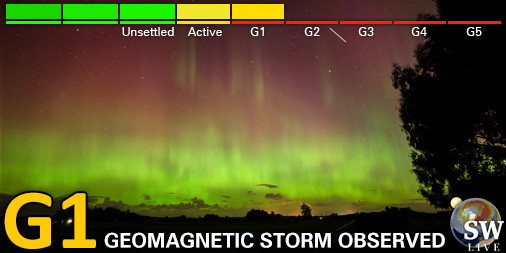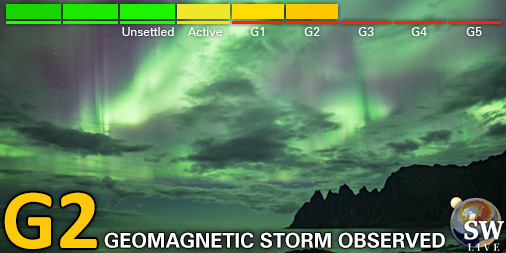Viewing archive of Saturday, 30 October 2021
Daily bulletin on solar and geomagnetic activity from the SIDC
Issued: 2021 Oct 30 1230 UTC
SIDC Forecast
Solar flares
M-class flares expected (probability >=50%)
Geomagnetism
Minor storm expected (A>=30 or K=5)
Solar protons
Quiet
| 10cm flux | Ap | |
|---|---|---|
| 30 Oct 2021 | 111 | 026 |
| 31 Oct 2021 | 108 | 034 |
| 01 Nov 2021 | 105 | 017 |
Bulletin
Solar flaring activity was low during the last 24 hours, with four C-class flares detected from two Active Regions (ARs). More specifically, NOAA AR 2887 produced two C-class flares and NOAA AR 2891 produced the remaining two. NOAA AR 2887 was very quiet when compared to its activity on 28 Oct and considering its magnetic complexity. Hence, an increase in activity is expected for the next 24 hours, with a fair chance of an M-class flare and a small chance for another X-class flare. NOAA AR 2891 is expected to continue producing a small number of C-class flares in the next 24 hours.
No Earth-directed Coronal Mass Ejections (CMEs) can be seen in the available corona images. A CME detected by CACTUS and seen in SOHO/LASCO-C2 images erupted on 29 Oct 18:40 UT, but it is located on the western edge of the visible solar disk and it not expected to be geo-effective.
The greater than 10 MeV proton flux as measured by GOES-16 remained above nominal levels in the last 24 hours. It is expected to drop below the 10 particles cm-2 s-1 sr-1 in the next 24 hours, unless another proton event occures. The greater than 2 MeV electron flux remained below the 1000 pfu alert threshold and is expected to remain below this threshold during the next 24 hours. The 24h electron fluence was at nominal levels and is expected to remain so.
The solar wind speed (as measured by DSCOVR) varied was very low, between 280 and 340 km/s during the last 24 hours. The total magnetic field decreased from 2 nT to 8 nT, while the Bz varied between -6 and +5 nT in the last 24 hours. The interplanetary magnetic field phi angle was predominantly in the negative sector (directed towards the Sun) during the last 24 hours. However, those conditions are expected to change drastically in the next 24 hours, as a fast Interplanetary Coronal Mass Ejection (ICME) is expected to reach Earth. The ICME is expected to be headed by a shock that will change rapidly several solar wind parameters.
Geomagnetic conditions were globally and locally quiet (NOAA Kp and K Dourbes 1-2). However, A fast ICME is expected to arrive later today and increase the K indeces to at least minor storm conditions.
Today's estimated international sunspot number (ISN): 069, based on 08 stations.Solar indices for 29 Oct 2021
| Wolf number Catania | /// |
| 10cm solar flux | 108 |
| AK Chambon La Forêt | 008 |
| AK Wingst | 002 |
| Estimated Ap | 002 |
| Estimated international sunspot number | 072 - Based on 25 stations |
Noticeable events summary
| Day | Begin | Max | End | Loc | Strength | OP | 10cm | Catania/NOAA | Radio burst types | |
|---|---|---|---|---|---|---|---|---|---|---|
| None | ||||||||||
Provided by the Solar Influences Data analysis Center© - SIDC - Processed by SpaceWeatherLive
All times in UTC
Current data suggests there is a moderate possibility for aurora to appear at the following high latitude regions in the near future
Whitehorse, YTFairbanks, AK
Current data suggests there is a slight possibility for aurora to appear at the following high latitude regions in the near future
Edmonton, AB, Gillam, MB, Saskatoon, SK, Yellowknife, NTAnchorage, AK, Juneau, AK, Utqiagvik, AK
Latest news
Latest forum messages
Support SpaceWeatherLive.com!
A lot of people come to SpaceWeatherLive to follow the Sun's activity or if there is aurora to be seen, but with more traffic comes higher server costs. Consider a donation if you enjoy SpaceWeatherLive so we can keep the website online!

Latest alerts
04:15 UTC - Geomagnetic activity
Minor G1 geomagnetic storm (Kp5) Threshold Reached: 04:05 UTC
03:15 UTC - Geomagnetic activity
Moderate G2 geomagnetic storm (Kp6) Threshold Reached: 02:59 UTC
01:00 UTC - Geomagnetic activity
Minor G1 geomagnetic storm (Kp5) Threshold Reached: 00:51 UTC
Friday, 4 April 2025
23:30 UTC - Geomagnetic activity
Minor G1 geomagnetic storm (Kp5) Threshold Reached: 23:17 UTC
21:03 UTC - Hemispheric Power Index
The OVATION model predicts the Hemispheric Power Index to reach 75GW at 21:49 UTC
Space weather facts
| Last X-flare | 2025/03/28 | X1.1 |
| Last M-flare | 2025/04/01 | M2.5 |
| Last geomagnetic storm | 2025/04/04 | Kp5+ (G1) |
| Spotless days | |
|---|---|
| Last spotless day | 2022/06/08 |
| Monthly mean Sunspot Number | |
|---|---|
| March 2025 | 134.2 -20.4 |
| April 2025 | 148 +13.8 |
| Last 30 days | 130.9 -15.2 |






